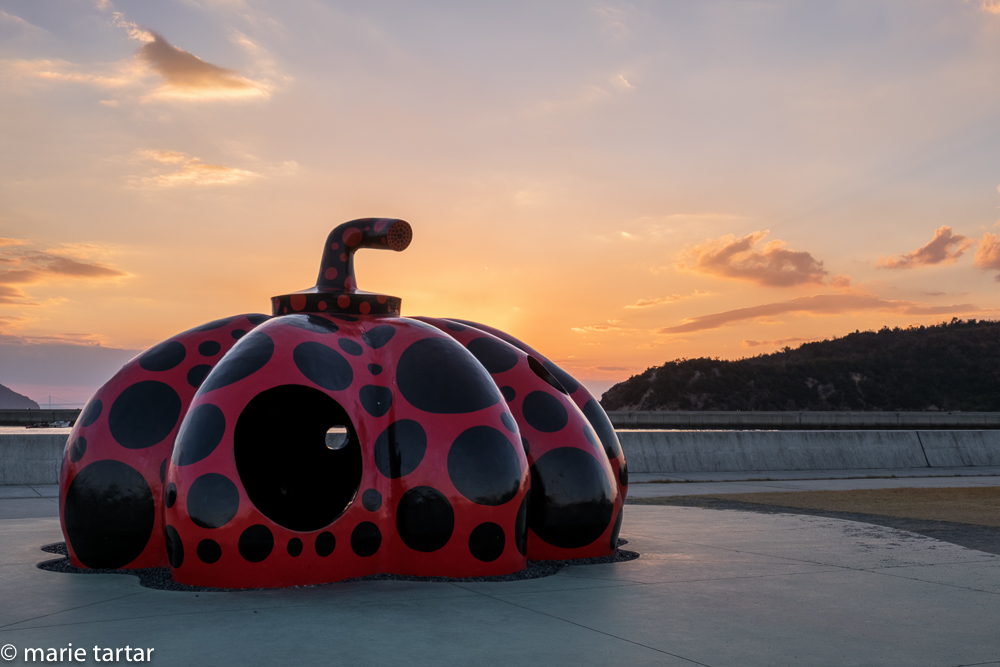
Thursday, November 10, 2016
We took our leave of the MOPA group the day before on a decidely down note, thanks to the unwelcome surprise of the US presidential results. The group was to spend a morning with Naomi, taking in iconic sights (the flaming orange torii gates of Fushimi Inari shrine and the towering wooden temple Kiyomizu-dera), and making an excursion to sensuous Sagawa Museum the following day. These are all fantastic favorites, but already known to us AND…I had been able to snag two consecutive nights in Oval at Naoshima Island, the inland sea contemporary art and architecture destination. Two years before, a typhoon encroached on our stay at Naoshima, preventing us from leaving Tokyo when planned (trains were grounded). The one night we did spend there was magic and we resolved to return.
Using Hyperdia, the indispensable app for comparing Japan rail itineraries (input a departure and arrival station, time and date, and it gives you alternatives, including track numbers, train names and numbers, total travel time, number of transfers), I had decided we were leaving on a 9:36 am shinkansen to Shin-Osaka, from which we would change to a super express Sakura. There was a simpler itinerary, boarding a later shinkansen going to Okayama, our destination, without transfers, but with enough stops to make it half an hour longer overall. This was going to be a transportation intensive day anyway, as once we made it to Okayama, then it was off the speedy shinkansen and onto chuggy local lines, first to Chayamachi, and finally to Uno, a port town, where we caught the 20 minute ferry to Miyanoura.
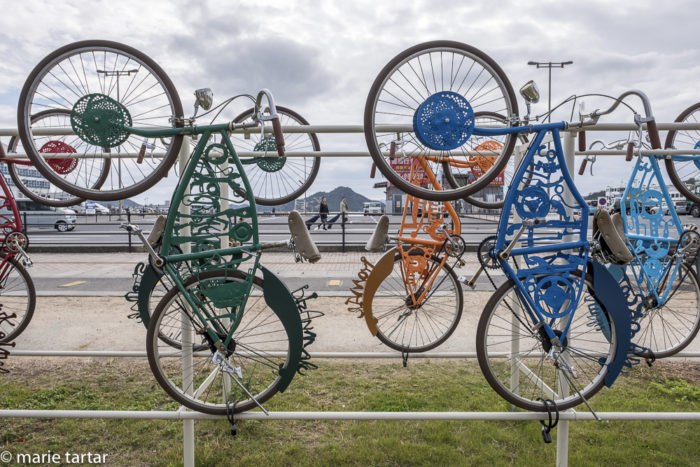
Two things I love together, bicycles and art! Beyond the Last Stop, by Atsushi Ozawa enlivened the trip to Naoshima, at Uno port; new from our prior trip, part of the Setouchi Triennale; I learned afterward these jazzy bikes could actually be rented!
We were eyeing the utterly adorable My Naoshima town bus, decorated with Yayoi Kusama dots and speckled pumpkins, when the Benesse House shuttle came along. Our room wasn’t ready, so we refueled at the Japanese Essen restaurant ( chicken and egg on rice (oyako don) for Steve, sea bream chazuke (fish on rice) for me, with chawan-mushi) before catching the bus to Honmura to spend the afternoon at the Art House Projects.
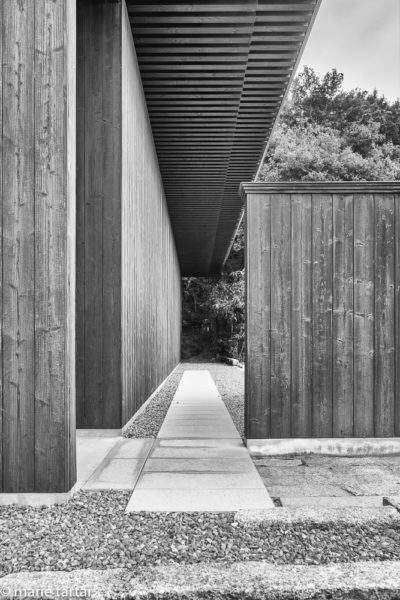
Minamidera, Honmura Art House project, Naoshima Island, Japan: Minami means south and dera means temple; the name refers to temples which once stood near this site. A wooden building by Tadao Ando houses a James Turrell optical work.
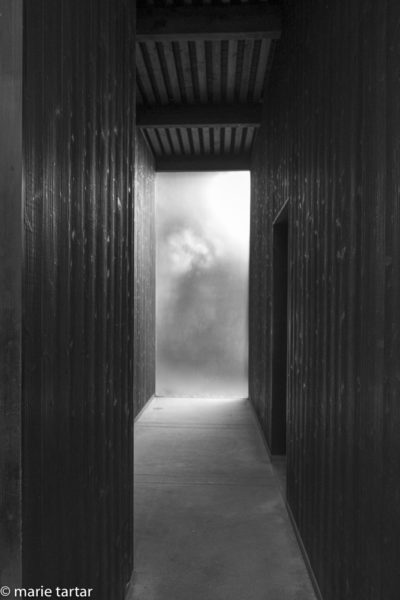
Minamidera, Naoshima Island, entrance to Ando’s structure housing a James Turrell installation; for some reason this vista makes me think of those miracle tortillas with images of Christ
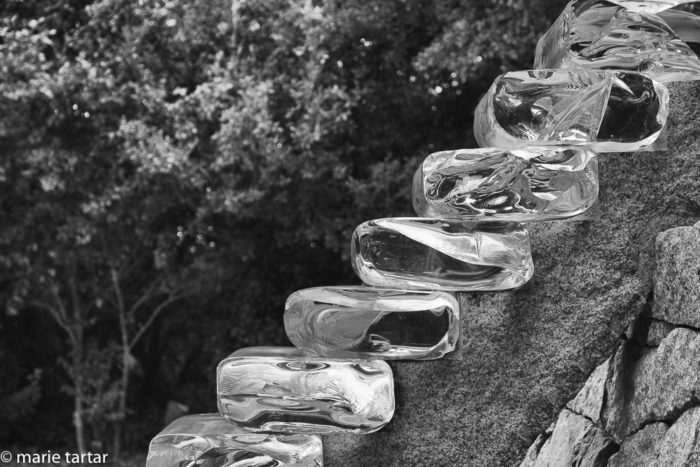
A descent into the underworld, a subterranean stone chamber at Go’o Shrine, an Art House project work by Hiroshi Sugimoto, building on an existing Edo era shrine
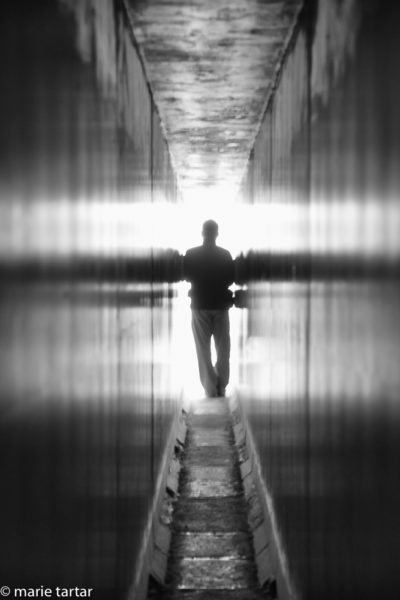
You’re my world, Steve Eilenberg (Go’o Shrine, Hiroshi Sugimoto, Art House Project, Honmura District, Naoshima island, Japan)
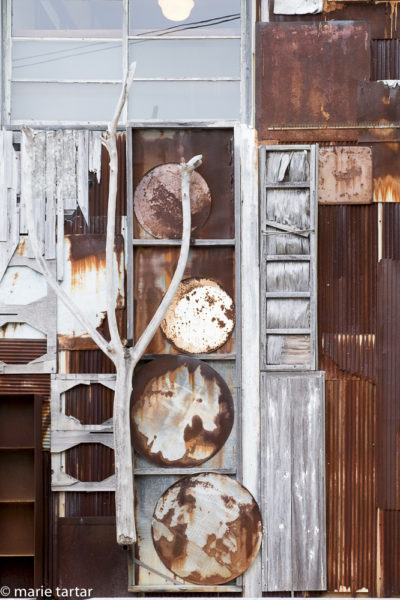
Haisha, 2006 Art House Project on Naoshima Island by Shinro Ohtake, was once a dentist’s office (ha=teeth, isha=doctor).
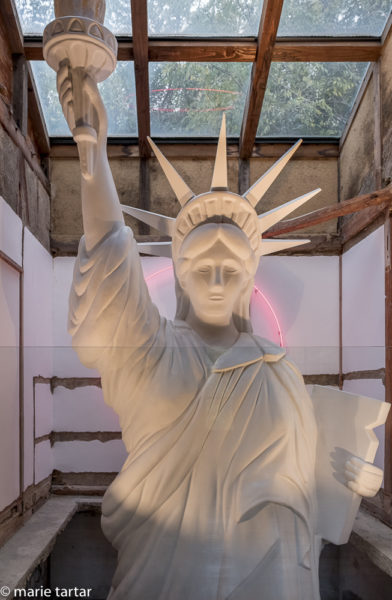
An Americana surprise inside Haisha, Naoshima Island, brought to mind the NYC Columbus Circle project of 2012, Discovering Columbus, of another Japanese artist, Tatsu Nishi, in which he surrounded the existing statue of Columbus, 60 feet in the air, with a living room (below).
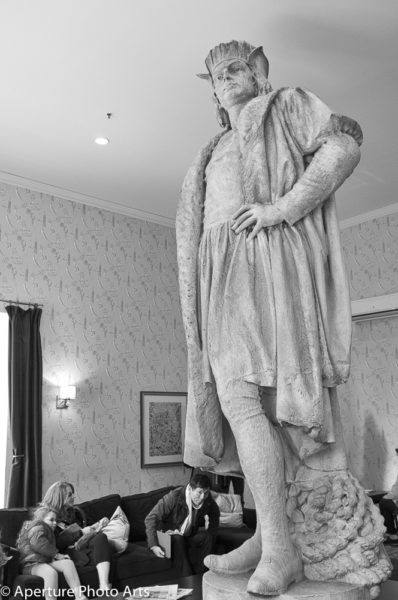
That’s some coffee table sculpture! Discovering Columbus, a 2012 work by Tetsu Nishi, in which the elevated, 60 feet in the air sculpture of Columbus at NYC’s Columbus Circle was encircled by a living room
James and Jill, and Katherine (incoming MCASD director) and her husband Dave were waiting for the bus when we returned, heading to the bathhouse art project. We both gasped at our first sight of Oval, after ascending up the 6 passenger monorail. We had a leisurely bento box dinner in our spacious room, decorated with pastel wall drawings by David Tremlett.

A celestial experience! Staying in Oval, a 6 room hotel by Tadao Ando at Naoshima Island, accessible only to guests by funicular
Friday, November 11, 2016
The view from our room, #404, at Oval, was also gasp-inducing, panoramic, framed by a curved wall of glass. Panels of glass descend into the ground at the touch of button. I awoke to a beautiful pre-sunrise blue hour, and should have shot it, but had not yet discovered we also had a door to the expansive terrace, hidden behind a bank of drapes.
Oval guests have their own continental breakfast in a small room which doubles as a bar on weekend evenings. This breakfast room was appointed with mud drawings by Richard Long, a Louise Nevelson black scuptural wall piece and a Yayoi Kusama print with her signature Naoshima spotted pumpkin .
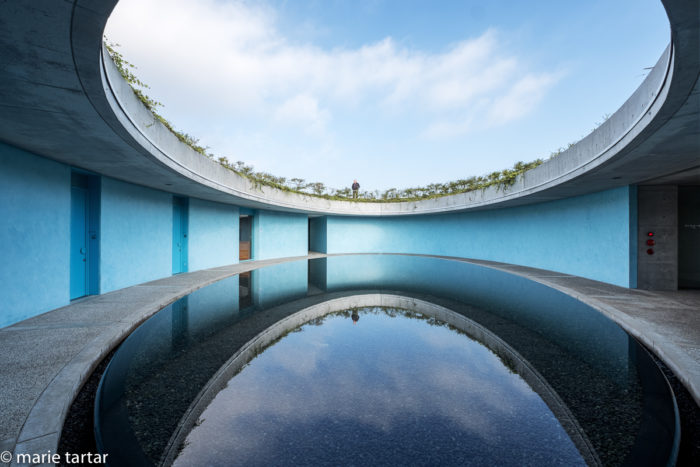
Ando-designed Oval hotel on Naoshima Island, by day, with Steve up on the living roof, a stellar experience, live living in your own James Turrell artwork
We followed the suggested Benesse House website itinerary for combining art viewing at two nearby islands, but went against the ferry crowd, going to more distant Inujima first, and Teshima second. The MCASD group we had seen the prior day had strongly endorsed going to Inujima, and we were blown away by what we found there on a tiny, sparsely populated island.
The Inujima Seirensho Art Museum occupies an abandoned copper smeltery. The original facility opened in 1909, but only operated for about 10 years, closing and never reopening when the price of copper dropped precipitously. This industrial heritage is preserved evocatively in stacks and other architectural artifacts alongside the museum building by architect Hiroshi Sambuichi. We had already admired a distinctive contemporary municipal building on Naoshima, new since our prior visit, which is also designed by Sambuichi:

Remnants of a long-closed copper smelting complex form part of Inujima Seirensho Art Museum, Seto Inland Sea, Japan
Like Naoshima, the surrounding islands have also become studded with contemporary art installations, many in abandoned, traditional houses, helping to revive the economies of languishing fishing communitites. Inujima’s Art House Projects were dotted between the museum and the ferry terminal, short easy walks apart.
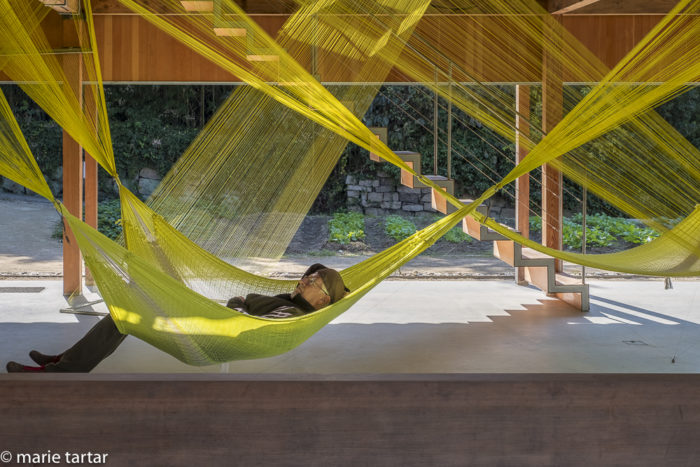
Steve rests in a hammock, part of the 2015 work “Ether” by Chinatsu Shimodaira at C-Art House (architect-Kazuyo Sejima; half of the Pritzker prize-winning firm, SANAA)

Another beautiful gallery space on Inujima Island designed by architect Kazuyo Sejima, F-Art House, houses a cosmically imposing 2013 work titled Biota (Fauna/Flora) by Kohei Nawa.

Steve as Che, striking a pose in one of the 3 mirrors making up Olafur Eliasson’s fun house work, Self Loop, at I-Art House on Inujima
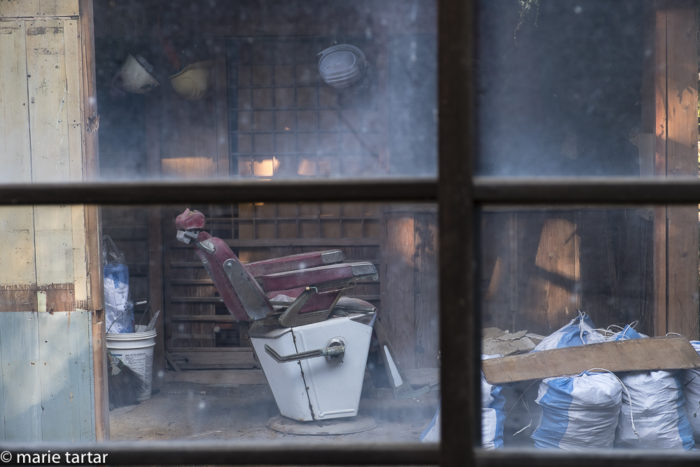
Another art house installation on Inujima? No, a derelict dentist’s office, I’m guessing…but it did bring to mind the eerie tableaux of Ed and Nancy Kienholz
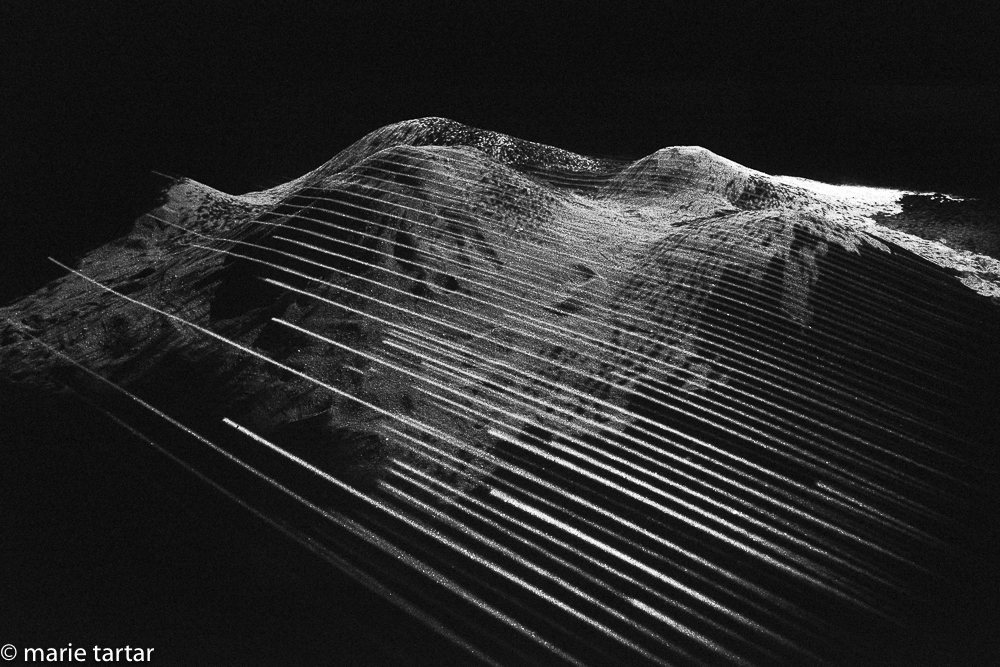
One last brilliant surprise awaited us at the Seaside Inujima Gallery. We both loved this video and sculptural installation by Keisuke Takahashi called The Fictional Island (2016). The “imaginary island” is composed of black slag, a by-product of the copper-smelting process, and recalls “the gradual border between the topography and landscape that separates the sea and the island, and the temporal border that connects the past and the future.”
Arriving at Teshima in the afternoon, another island in Kagawa prefecture surrounded by the Seto inland sea, we learned we were too late for the hourly bus which could take us to our destination.
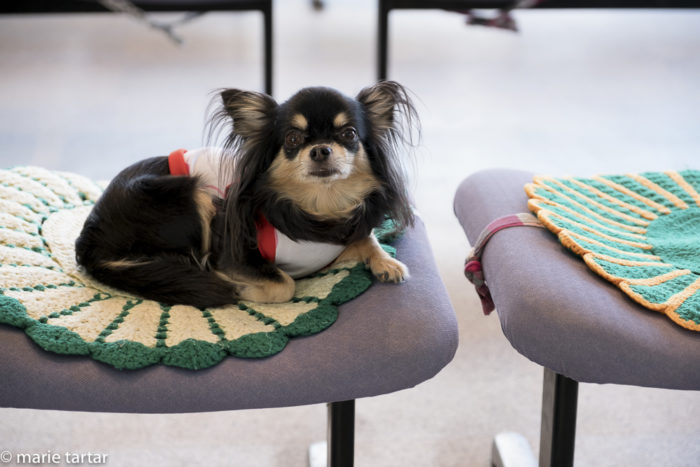
So wrong it’s right?! Only in Japan, crocheted seat covers in the ferry terminal, Teshima Island, Seto Inland Sea
It turns out there is only one taxi on the island-would we like it called? Six minutes later, we were zooming uphill, past bikers pushing their steeds uphill alongside rice fields.
The Teshima Art Museum is not a museum in the usual sense of a building housing works of art. Rather, it is a structure which is at once a water feature, shelter and art installation in one. It is completely unique and quite extraordinary. It is a collaboration between Tokyo-based, Pritzker prize-winning architect Ryue Nishizawa and Japanese artist Rei Naito. The approach is through a forested path around Mt. Myojin, culminating in arrival at a white orb. Described on the website as evoking a water droplet, I’d favor a space ship. It is open to the air and serves as a shell from which to contemplate wind whistling, lightplay and bird songs. There is a surprising, minimal water element which completes the marvel of the ensemble, which must be experienced to be understood. As we frequently encountered at these unique art projects, photography is forbidden. Since people are so selfie-happy these days, that is an understandable, but eminently frustrating, policy. Around this time, Steve made me aware of the completely silent electronic shutter option in our cameras, which helped to surreptitiously, albeit minimally, document our experience.
The Teshima Art Museum is set in the midst of rice fields, which had fallen fallow, but were restored with the aid of local residents in 2010. The landscape, with nice views of the sea and a short trail through the fields, enhances the experience of this unique orb. We caught the bus back, amortizing our transportation expenses, leaving us just enough time to visit the Teshima Yokoo art house project and a stop into a comfortable cafe.
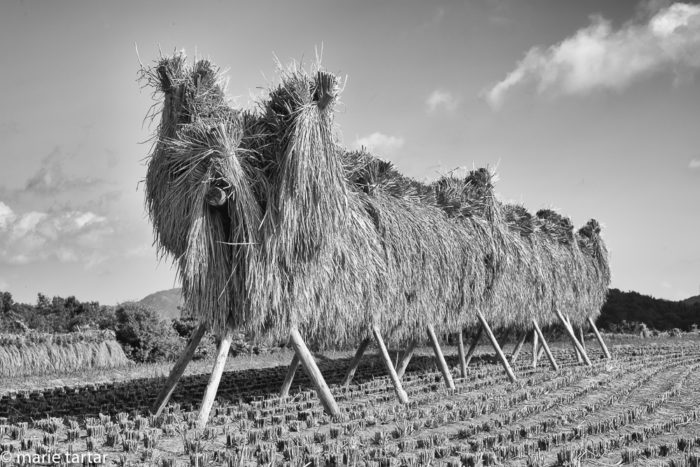
Drying rice sheaves, next door to Teshima Art Museum; I half expect this to come to life, like a Chinese New Year dragon or a Japanese matsuri festival figure.

A strange and compelling red light emanated from the Teshima Yokoo House, Teshima Island, Seto Inland Sea, Japan (architect Yuko Nagayama)

The sign outside “A place for coffee and community art in Teshima” drew us into this coffee shop near the Teshima Island ferry terminal
Dinner at the Terrace Restaurant (also known as Umi no Hoshi or Etoile de la mer (Star of the Sea)) was a delicious multi-course affair, set off by a wine pairing.
Saturday, November 12, 2016
Another activity deferred by a typhoon 2 years before, finally realized. The night before, I realized that the earliest hotel shuttle bus would get us to Miyanoura port too late for the high-speed ferry we needed to catch to make our appointment time at the Isamu Noguchi Garden Museum. A short discussion with the front desk fixed the problem: “A member of our staff will drive you.” We had to pack, as we were checking out of Oval and into Park, but the staff made that painless as well. We walked down and a staff member whisked us down to the port in plenty of time to catch the 8:40 ferry, landing us in Takamatsu at 9:05 am. Our tour was scheduled for 10 am. A 25-minute cab ride, vs. taking the adorable 2-car local train 5 stops (free, since it was a JR train and our passes were still good), then a 10-minute cab ride. We were looking at a map at Yashima JR station and debating if it was walkable, but a friendly station ambassador advised against it, and we certainly would have been late if we had attempted the walk. We were 10 minutes early, and alone for a few minutes. Another couple materialized, who we starting chatting with later (Sally and Wids), and then a busload of Japanese tourists. Thankfully, they divided us into a tiny English speaking group of 6 and everyone else.
Noguchi is a long-time hero of mine. He is also “hafu” (half Japanese and half American), and a giant of mid-century design. Best known perhaps for his sculpture, he was active in landscape and plaza design, and created iconic furniture and lighting, many designs still being produced. I loved his Akari paper lamp sculptures in design magazines as an impoverished student, so am thrilled to have a small collection today, which give me daily pleasure. Akari means light in Japanese. The sun and moon characters used to form the word imbue the sense of sunlight or moonlight pouring into a room. They are still made by the same family owned business in Gifu, where one of my aunts lives and where my mother went to college. Gifu was a known manufacturer of paper parasols and lanterns when Noguchi visited Gifu and began producing Noguchi’s Akari after 1951.
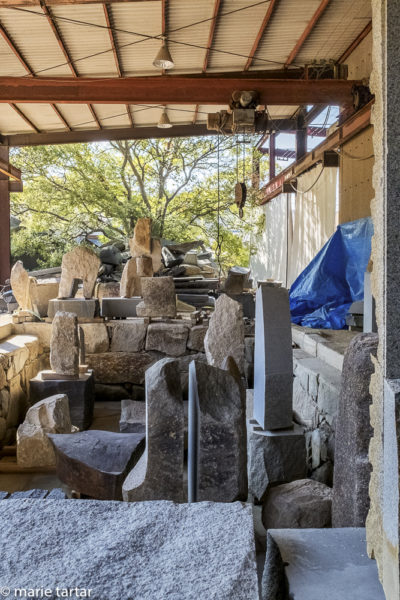
Noguchi first came to Mure, near Takamatsu, Shikoku Island, Japan, in 1956 in search of stone for his project for the UNESCO headquarters in Paris.
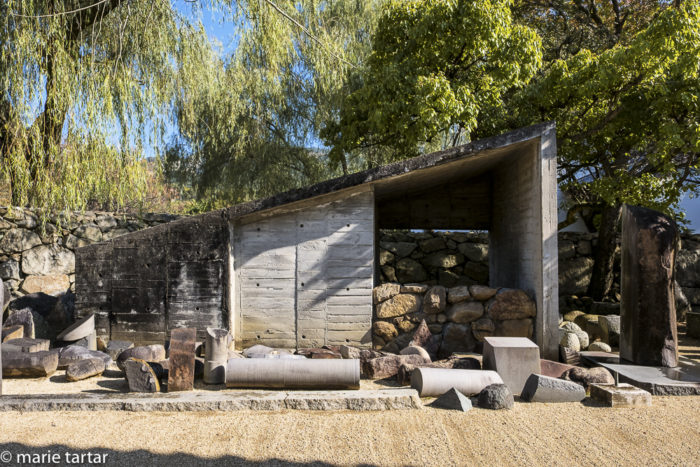
In the last 2 decades of his life, Noguchi spent 6 months of each year at this studio compound in Mure, collaborating with a local stone cutter named Masatoshi Izumi.
I only managed a few furtive shots, as photography was again forbidden. It is a beautiful, peaceful, contemplative compound, well worth a visit for art and architecture lovers. By the end of our sojourn in Noguchi’s idyllic compound, we had bonded with Sally and Wids over a mutual love of art, landscape and architecture coupled with a profound sense of unease over the election results.
Our return to the ferry terminal didn’t go quite as envisioned. It started out well, with the Noguchi staff calling us a cab. Once at Yashima JR station again, I realized the hourly train had left 10 minutes before and the next train, almost an hour later, would get us to Takamatsu station (near the ferry terminal) a few minutes too late to make the 1:40 pm ferry. There was no help for it. Thankfully, a cheerful and chatty Japanese lady in the station willingly called us a cab.
Back on Naoshima, we learned Naoshima had been the setting for the last James Bond novel by Raymond Fleming, Man with a Red Tattoo. This little-known fact we learned at the museum devoted to memorializing it, called 007: Man with a Red Tattoo Museum. We also learned there had been a campaign to have the movie shot there, should it ever be adapted for the big screen. Passing a cafe from which delicious aromas emanated, we were drawn in for fisherman’s cuisine, namely, a grilled fish and sashimi lunch at Uogashi 7070, an auberge-style guest house restaurant.
This left just enough time to eyeball the exterior of the bathhouse turned art project, but not enough time for a soak.
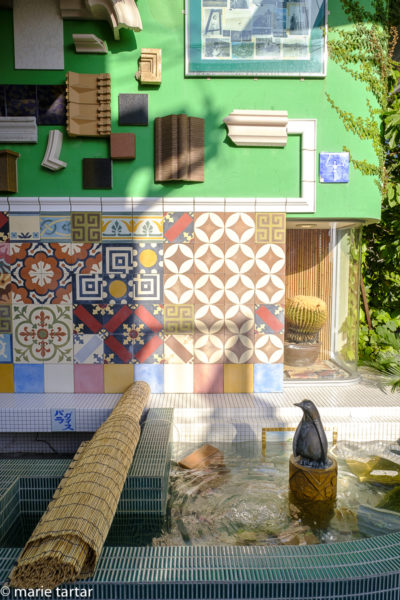
That patchwork quilt aesthetic of Shinro Ohtake pops up again at a refurbished Art House Project and public bathhouse, Naoshima Bath. Sadly, we didn’t get a chance to “experience art with our whole body” on this trip either!
We caught the bus to Honmura to catch the few Art House Projects we hadn’t seen the other day, namely beautiful Ishibashi and contemplative Kinza, which required advance reservation. We also took a quick spin through the Ando Museum, another >100 year old structure converted by the architectural giant.
One of the Art House Projects which required advance reservation was Kinza. Being Given (2001) is the work of Rei Naito, one of the collaborators behind the Teshima Art Museum. This work transforms a 200 year old traditional Japanese house into a dark and quiet meditative space. Each entrant is allowed 15 solitary minutes inside the space, a rare experience indeed.
Back at the hotel, our luggage had been transferred to our new room in Park.

Cultivating the next generation of art lovers, on the grounds of Benesse House Museum, Naoshima Island, Japan (Niki de Saint Phalle’s Le Banc, 1989)
We joked about how we’d come down in the world, from the huge suite and terrace at Oval (and bill to match) to a perfectly fine, but significantly smaller room at Park, with a proportional terrace. It did have a nice view of the water, and the lights of Takamatsu, if not the top of the world panorama of Oval. Even the beds were smaller, two singles instead of two doubles. And we had to make do with a simple Toto toilet with only 3 rinsing options and had to actually TOUCH the toilet to flush-yes, a manual flush handle! Every time I encountered one of these stripped down Totos with a flush handle, I recalled Stephanie emerging from the bathroom at Robert Yellin’s gallery with a confounded look on her face. As I approached, she whispered, “I’ve pushed ALL of these buttons, but…how do you make this flush?” The current generation of Japanese toilets are a technological wonder, with a panel of options to select, from musical accompaniment to rushing water sounds, to a variety of rinsing options…the only one which seems to me a really desirable luxury/possibly a necessity is the heated seat. Strangely, these high-tech toilets are often paired with a tiny sink, with only ice cold water and no soap, which seems odd.
Our room is Park was nicely appointed, but in need of touch up paint…almost anything would seem a come-down after Oval. Initially, only 2 consecutive nights were available at Oval. I had considered staying in Takamatsu, since we had the Noguchi studio visit already set up, but late in the game, a room opened up at Park, simplifying the logistics.
I spent our last evening at Naoshima, shooting down by the beach, lit by moonlight.
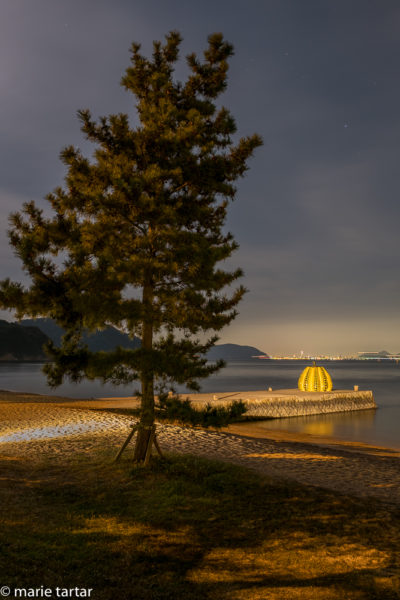
Yayoi Kusama’s iconic pumpkin at Benesse House in Naoshima Island has become a symbol of the “art island”.
The logistics of our final return were considerable. Only in Japan, land of to-the-minute-punctual trains, would I think it reasonable to embark on a return transportation program with so few contingency options. The night before, I considered a variety of options presented by Hyperdia, looking at earlier vs. later departures, trying to build in a bigger margin for error. But, leaving earlier seemed only to buy us longer waits on intermediate stops. There are such a variety of trains, of varying speed and number of stops, I put my faith in Hyperdia.
Here’s how our final day broke down:
10:45-10:55 am: Caught the hotel’s shuttle bus to Miyanoura port. I leapt off the bus and vaulted into the ferry terminal to buy tickets to Uno (which can’t be reserved in advance), leaving Steve to corral our luggage off the bus.
11:10-11:30 am: 20 minute ferry ride to Uno. We are second in line to exit the ferry, backpacks on and rolling across the street to the train station as soon as the barrier chain is removed. This is the critical, rate-limiting step; if we don’t make this train, we’re sunk.
11:38 am-12:02 pm: 24 minute train ride to Chayamachi. It’s a small local train, hot enough to make me regret choosing a “I hope the plane isn’t cold” black turtleneck in which to travel. We are lucky to have seats. At Chayamachi, we transfer to another local train for Okayama. We have 7 minutes, but this is easy, as our next train is on the adjacent platform.
12:09-12:29 pm: 20 minute train ride to Okayama. Arriving in Okayama, we transfer to the Shinkansen station, and start to breath. The tricky interchanges are behind us.
12:58 -13:42 pm: 44 minute super-express ride on the Sakura shinkansen, with only one stop before arriving at Shin-Osaka. Once there, we have 18 minutes to make our way to our final train of the day, the limited express Haruka.
14:00-14:50 pm: Our final leg, the Kansai airport bound Haruka, a 50 minute trip. One bus ride, one ferry ride, and 4 train rides, all in a span of 4 hours! Quite a transportation feat, taking us from a small sleepy art island in the Inland Sea to Kansai airport and towards a 10 hour flight to LA, customs and immigration within a 3 hour layover in LA, a 50 minute final flight to San Diego and a 30 minute car ride home, arriving earlier on the same day than when we departed, an everyday, modern miracle!
One bus ride, one ferry ride, and 4 train rides, all in a span of 4 hours! Quite a transportation feat, taking us from a small sleepy art island in the Inland Sea to Kansai airport and towards a 10 hour flight to LA, customs and immigration within a 3 hour layover in LA, a 50 minute final flight to San Diego and a 30 minute car ride home, arriving earlier on the same day than when we departed, an everyday, modern miracle!
As I hustle making these transitions, I imagine a less mobile, less able to hoist luggage and climb stairs older version of myself, and am happy we’re doing this while we can. The keys…besides a good set of knees, are a JR railpass (show it to an official and you’re waved onto the platform, without digging out money and waiting in lines to buy tickets) and not taking any more luggage than you can easily manage yourself. For non-diving trips like this, that means one rolling carry-on each, as well as one photo backpack each, with cameras, lenses and laptops.
To prolong my stay in Japan temporarily, I indulged in a mini-Japanese film festival on the return flight, seeing a 2016 black comedy called “Black Widow Business”, and a charming nocturnal community drama set in a “Midnight Diner”. Although this trip went a long way to filling in many gaps we missed thanks to 2014’s typhoon, we STILL did not manage to see all of the art offerings in this particularly scenic corner of Japan. There’s only one remedy…a return trip, maybe in 2019 when the sensory overload will be even more overwhelming during the every-3-year art fair, the Setouchi Triennale.
-Marie
If you missed the prior installments and want to prolong your virtual trip to Japan, here are links:

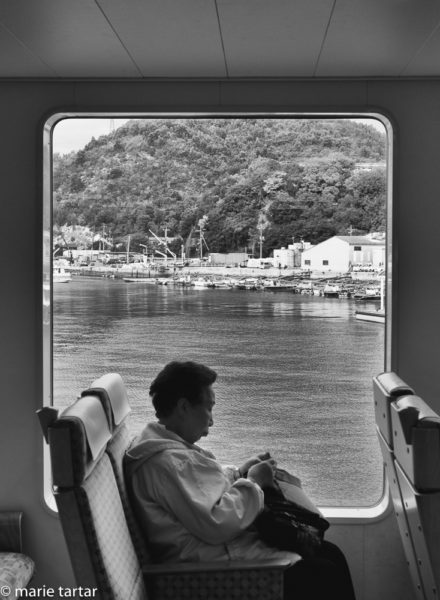
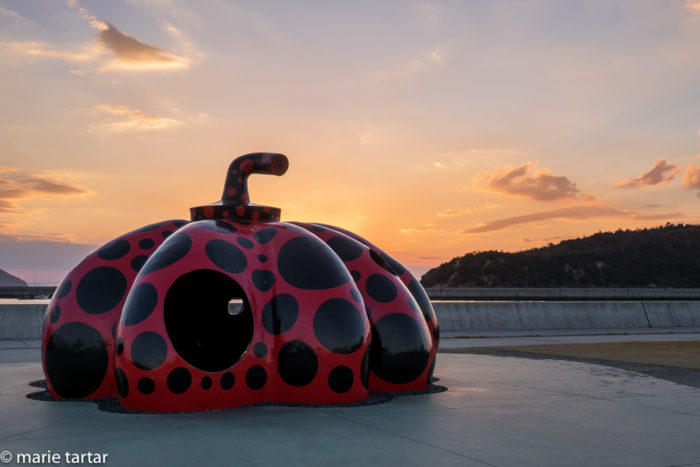


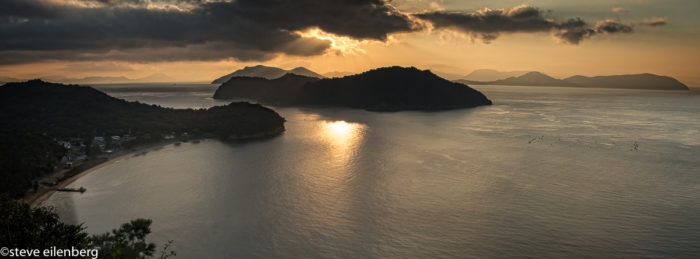
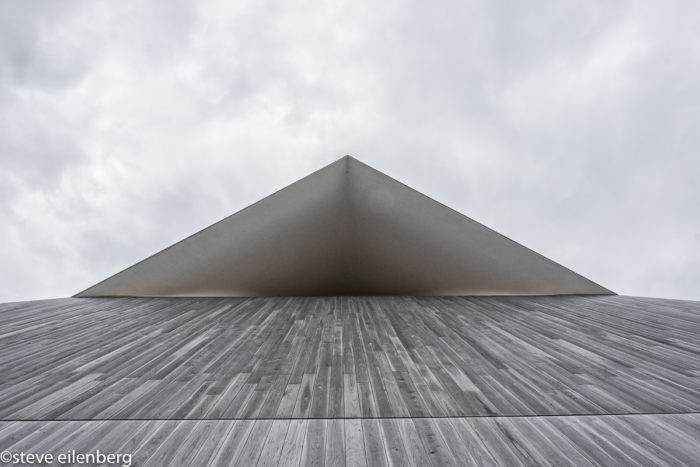


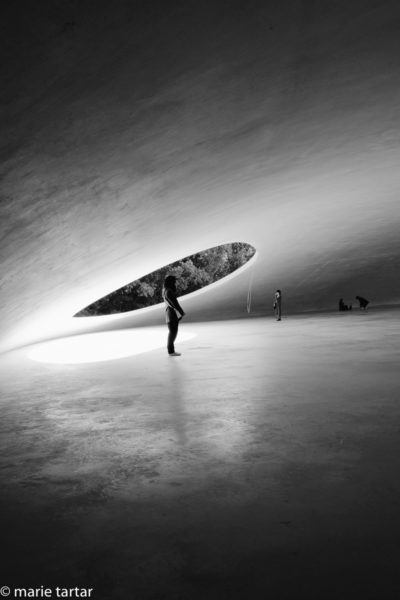

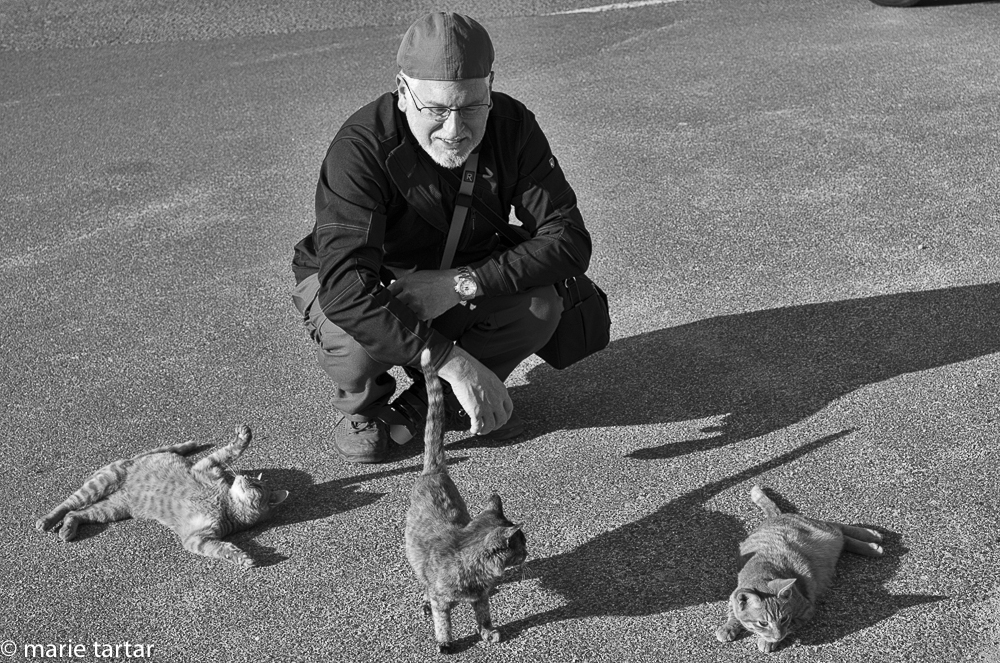

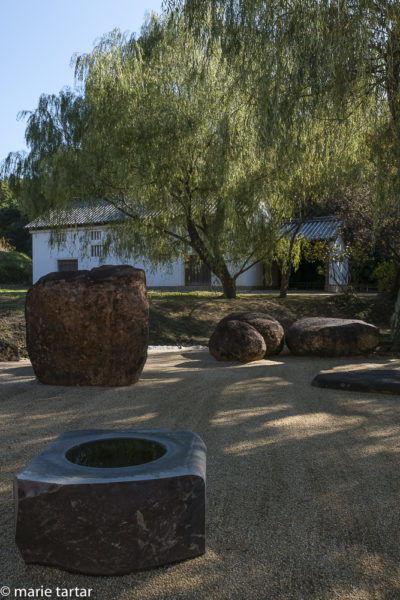
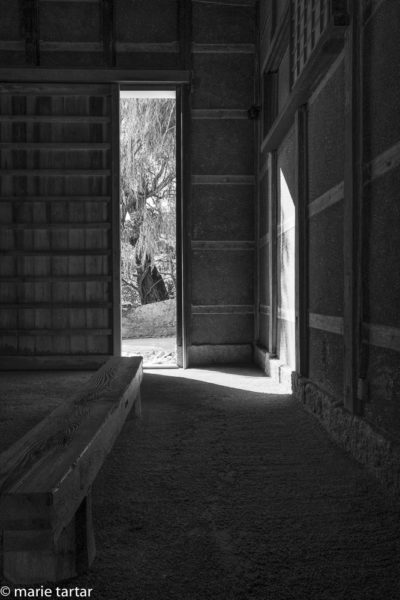
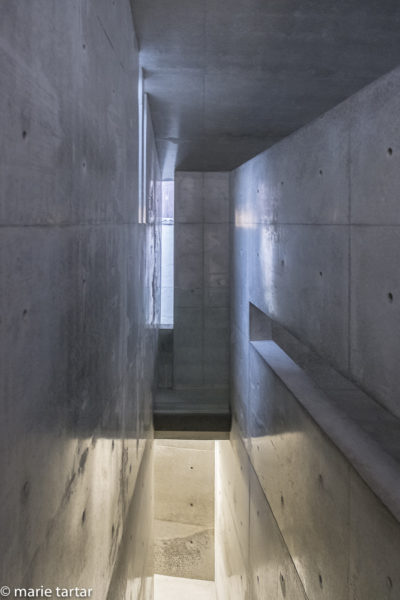
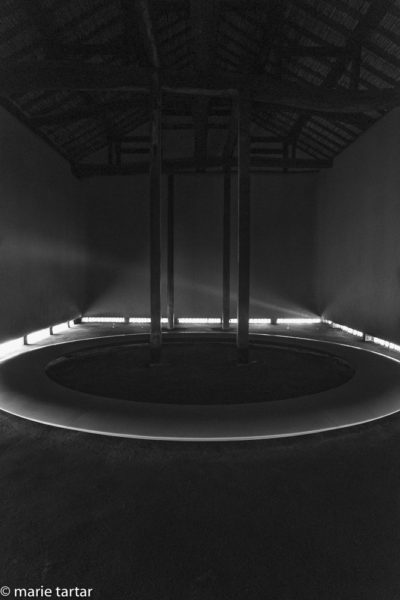


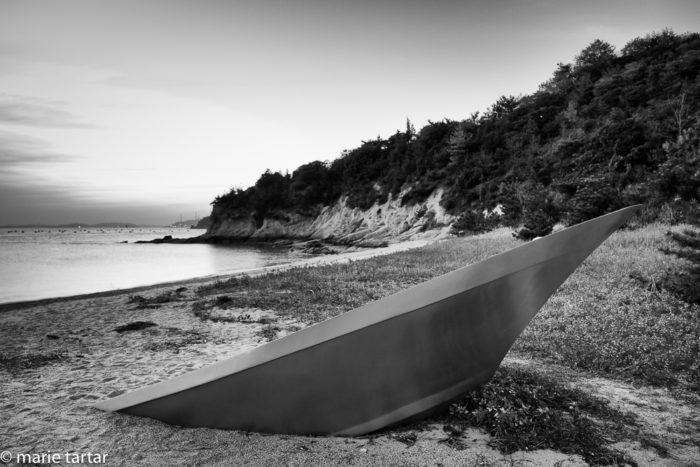
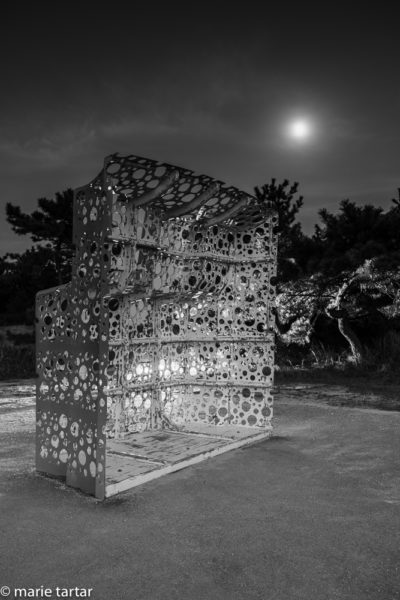
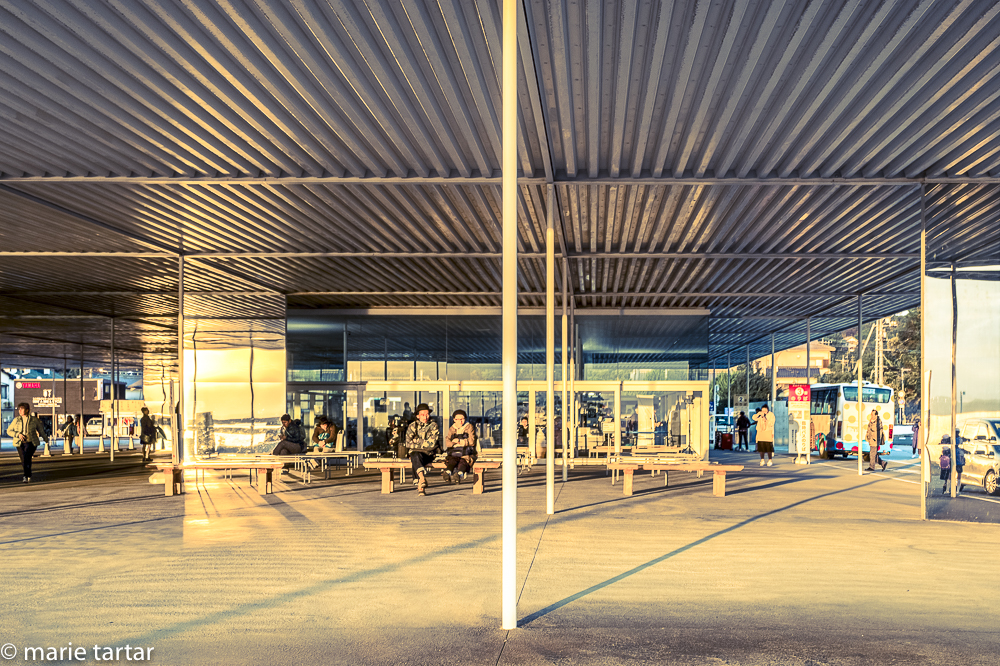
Really wonderful pictures Marie! I kept looking for the “like” button.
Thanks for looking, Rebekah, it is a beautiful & inspiring place!
-Marie